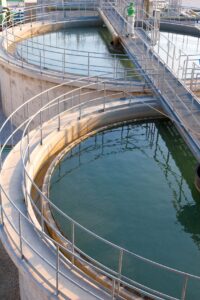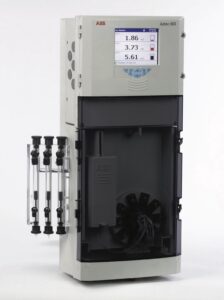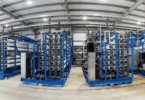While phosphorous may be a staple of healthy plant growth, its presence in water systems can prove problematic if allowed to build up to excessive concentrations. In this article, Julian Edwards of ABB Measurement & Analytics in the UK explains why phosphate levels in water need to be controlled and how ABB’s analytical technologies can be deployed to help to make phosphate measurement easy.
The nuances of water chemistry require a careful balance of substances to ensure optimum conditions for aquatic plant life and organisms and reduce the effort needed to turn raw water into safe, fresh potable water supplies. For this reason, the quality of water discharged to the environment needs to be controlled to ensure this balance is kept. Achieving this requires various specific parameters to be continuously and accurately checked to keep them within acceptable limits.
One such parameter is phosphorous. While highly beneficial for plant growth, phosphorous in its phosphate form can pose a serious threat to the health of aquatic systems if its levels are not controlled. High levels of soluble reactive phosphate (SRP), for example, are a key culprit behind the growth of algal blooms on lakes, reservoirs and rivers. While the abundant greenery of algal blooms may provide a picture of environmental harmony on the surface, the impact they have under the surface is anything but harmonious. Capable of rapid growth, algal blooms can quickly accumulate and destroy aquatic environments by consuming dissolved oxygen in the water.
Known as eutrophication, this problem can render whole bodies of water lifeless, killing fish and other aquatic life and generating unpleasant and toxic odours as the algae decays. As a further problem, algal blooms can also contain blue-green algae, known as cyanobacteria, which can release potentially harmful toxins into the water that can cause complications during potable water treatment.
Keeping phosphates under control
There are several ways that phosphate can find its way into water.
The largest contributor is agriculture. Phosphates are a main ingredient in many agricultural fertilisers and are used to encourage the growth of various types of crops by improving their ability to perform various key functions including photosynthesis and energy storage. Delivered as a liquid fertiliser or ploughed into fields, phosphates bind to soil particles. In locations near to streams or rivers, these particles can be washed into the water, raising phosphorous levels and increasing the risk of algal formation.
Other sources include surface run-off from lawns and public areas such as parks and golf courses, wastewater from industry and sewage. In the case of sewage, contributors can include common household detergents and human excreta which carry phosphate-based compounds. It can also occur naturally, in rocks and minerals and from living organisms.
With even levels of 0.05mg/l of phosphates being sufficient to form an algal bloom, there is a need for levels to be tightly controlled before treated effluent water can be safely discharged to the environment. As well as limiting the risk of potential damage to the environment, there is the added need for measurements to be used as proof for regulatory consent requirements which are in place in many countries. In the UK, for example, where input levels are related to the size of the area being served and the characteristics of the water that is being discharged to, levels need to be maintained at the technically achievable limit (TAL) of 0.25 mg/l to satisfy phosphate discharge consent requirements, with operators obliged to demonstrate compliance to ensure that the necessary treatment requirements have been met.


The benefits of continuous online phosphate measurement
While manual sampling methods continue to have their place in water treatment, particularly as a means of verifying online instrument performance, significant advantages can be achieved by using online measurement equipment to continuously measure parameters.
Given the 24 hour, seven days a week, 365 days a year nature of wastewater treatment, it is particularly important to have systems in place that can provide an accurate indication of process performance and final water quality for any given moment in time.
Capable of measuring around the clock, online phosphate measurement analysers can be used to provide real or near-real-time data on phosphate levels. This data can be used both for compliance purposes and, if necessary, to help fine-tune treatment process performance, such as adjusting dosing of ferric chloride or aluminium sulphate during coagulation to reduce phosphate levels.
The benefits of using online phosphate analysers is highlighted by an application at UK water company, Severn Trent Water. Faced with the need to accurately measure phosphate levels in wastewater effluent to meet consent limits set by the Environment Agency, Severn Trent Water opted to install 120 ABB Aztec 600 phosphate analysers at wastewater treatment plants throughout its operating area which have a phosphate consent limit in place.
Operating alongside ABB iron and ammonia analysers and turbidity monitors, the phosphate analysers, which operate on the colorimetric principle and can measure phosphate levels down to 0.0016mg/l, have reduced the company’s reliance on manual sampling, which had previously only enabled it to derive data for a specific time and set of operating conditions. Using the resulting data, the company has been able to find ways to optimize its effluent treatment processes to ensure that phosphate levels can be reduced and maintained to meet the Environment Agency’s consent target.
As an added benefit, the availability of real-time data has also enabled Severn Trent Water to create a more proactive maintenance schedule matched to the actual needs of its treatment plants. The greater visibility provided by the data from the phosphate analysers has enabled the company to spot any potential malfunctions or issues before they can escalate, improving its ability to deploy its maintenance teams and giving them the information they need to fix any issues in advance.
As a means of continually monitoring water quality throughout the water treatment process, online measurement instruments such as the Aztec 600 phosphate analyser can offer a number of cost saving benefits compared to manual sample collection and analysis.
Foremost amongst these is the ability to optimize plant operation and output consistency through:
- Reduced likelihood of problems caused by regulatory breaches or non-compliance
- Optimizing chemical dosing and reducing costs
- Reduced operator intervention through the ability to carry out automatic monitoring
- Decreased levels of sludge, leading to a reduction in the cost and resources connected with sludge disposal
Making phosphate measurement easy
Maximizing the quality of wastewater discharged to the environment is a major part of the overall need to manage water resources more sustainably to meet growing demands from a rising global population. As such, the ability to measure key parameters such as phosphates to help minimize the risk of environmental damage arising from issues such as algal bloom formations can help to ensure that available stocks of treatable water can be readily utilised.
As a way of providing a picture of current conditions, on-line phosphate monitoring enables a level of process control that is not possible with manual testing alone, enabling much greater control over phosphate levels and minimizing the risk of compliance breaches.
For more information about how online analysis technology can help optimize phosphate measurement and control, visit www.abb.com/measurement.
Do you have an article that you would like to share? Please click here to submit or if you’d like to subscribe to our weekly newsletter, please click here.







